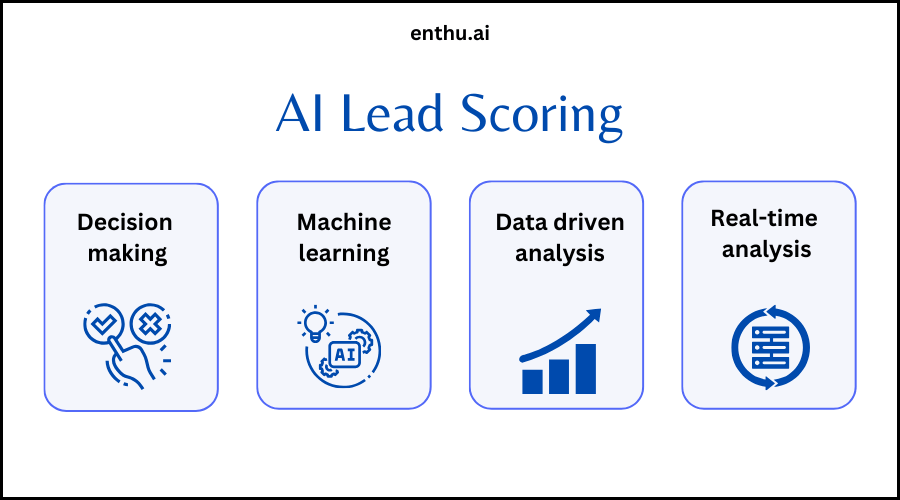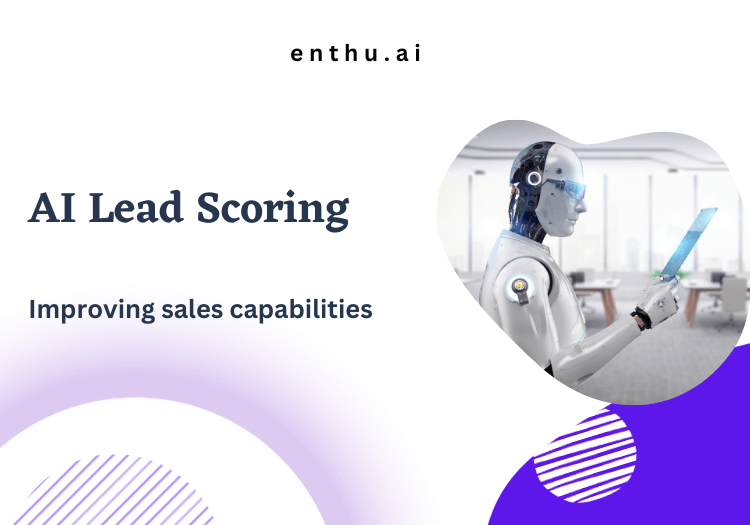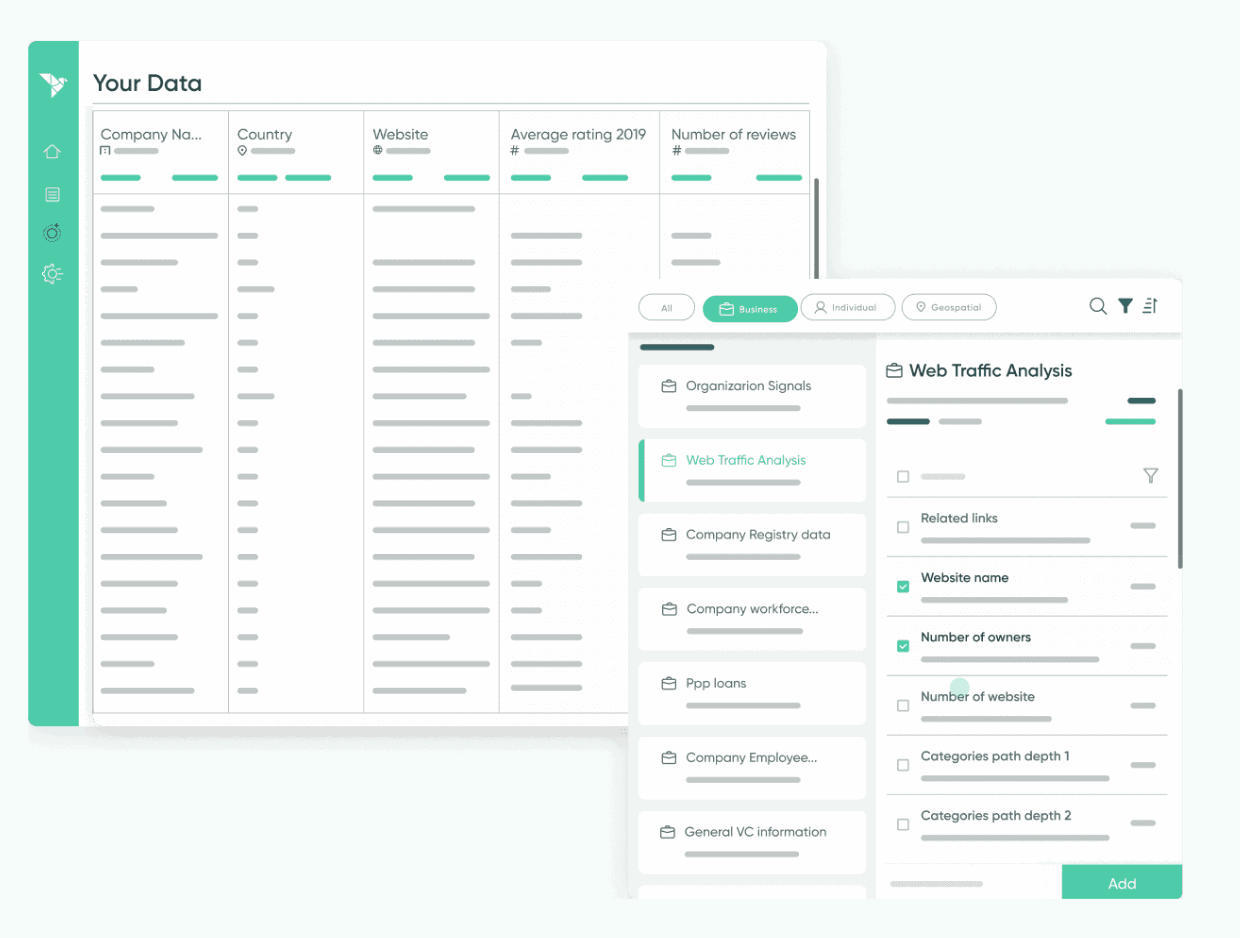AI-driven Lead Scoring revolutionizes sales and marketing by leveraging artificial intelligence to predict which leads are most likely to convert. Unlike traditional methods relying on manual rule-based systems, AI algorithms analyze vast datasets from multiple sources, identifying subtle patterns and insights that significantly improve lead qualification accuracy. This leads to more efficient resource allocation, higher conversion rates, and ultimately, increased revenue.
This guide delves into the core concepts of AI-driven lead scoring, exploring its benefits, data integration challenges, algorithm selection, model training, and ethical considerations. We’ll examine various machine learning techniques, showcasing real-world applications and case studies to illustrate the transformative power of AI in lead management. Practical advice on visualizing results and presenting insights to stakeholders will also be provided.
Defining AI-Driven Lead Scoring
AI-driven lead scoring represents a significant advancement in sales and marketing, moving beyond traditional methods to leverage the power of artificial intelligence for more accurate and efficient lead prioritization. It uses machine learning algorithms to analyze vast datasets, identifying patterns and predicting the likelihood of a lead converting into a paying customer. This contrasts sharply with traditional methods, which often rely on simpler, rule-based systems.AI-driven lead scoring analyzes a much broader range of data points than traditional methods, leading to more nuanced and accurate predictions.
This allows sales and marketing teams to focus their efforts on the most promising leads, optimizing resource allocation and improving overall conversion rates. The increased accuracy and efficiency translates directly into improved ROI for businesses.
Key Benefits of AI for Lead Scoring
The advantages of using AI for lead scoring are numerous and impactful. AI significantly enhances the accuracy and efficiency of lead qualification, leading to better resource allocation and improved sales outcomes. Furthermore, AI systems can adapt and learn over time, constantly improving their predictive capabilities as more data becomes available. This continuous learning loop allows for increasingly refined lead scoring models that become more accurate with each passing day.
Finally, AI automates much of the manual process, freeing up valuable time for sales and marketing teams to focus on other strategic initiatives.
Industries Benefiting from AI-Driven Lead Scoring
Several industries are experiencing significant benefits from adopting AI-driven lead scoring. The technology is particularly impactful in sectors with complex sales cycles or large volumes of leads. For instance, the SaaS industry uses AI to predict churn and prioritize high-value leads based on usage patterns and engagement metrics. Similarly, the financial services sector benefits from AI’s ability to identify high-net-worth individuals and assess their risk profiles for targeted marketing campaigns.
Even the healthcare industry utilizes AI for lead scoring, identifying patients most likely to benefit from specific treatments or services based on medical history and other relevant data.
Comparison of Traditional and AI-Driven Lead Scoring
The table below illustrates the key differences between traditional and AI-driven lead scoring approaches.
| Method | Data Used | Scoring Logic | Accuracy |
|---|---|---|---|
| Traditional Lead Scoring | Basic demographic data, website activity (limited), email engagement | Rule-based, pre-defined scoring criteria | Moderate; prone to inaccuracies and bias |
| AI-Driven Lead Scoring | Demographic data, website activity (extensive), email engagement, social media interactions, CRM data, purchase history, firmographic data | Machine learning algorithms, predictive modeling | High; continuously improves with data |
Data Sources and Integration

AI-driven lead scoring relies on a robust and comprehensive data pipeline, drawing information from various sources to create a holistic view of each lead. The accuracy and effectiveness of the lead scoring model are directly dependent on the quality and integration of this data. Efficient data management is crucial for generating meaningful insights and maximizing the return on investment.The integration of data from diverse sources presents unique challenges.
Data inconsistencies, varying formats, and the sheer volume of information necessitate careful planning and execution. Without proper attention to data quality and integration, the resulting lead scores will be unreliable and potentially misleading.
Data Sources for AI-Driven Lead Scoring
Several key data sources contribute to a comprehensive lead profile. These sources provide different facets of lead behavior and characteristics, enabling a more nuanced and accurate lead score. The combination of these data points allows for a more precise prediction of a lead’s likelihood to convert.
- CRM Systems: Customer Relationship Management (CRM) systems store valuable information on customer interactions, purchase history, support tickets, and other engagement details. This data provides insights into past behavior and preferences.
- Marketing Automation Platforms: These platforms track email engagement, website activity, and responses to marketing campaigns. Metrics such as open rates, click-through rates, and form submissions are crucial for lead scoring.
- Website Analytics: Tools like Google Analytics provide data on website traffic, user behavior, and page views. This information helps identify engaged leads and those who are actively researching products or services.
- Social Media Data: Social media platforms offer insights into lead demographics, interests, and online conversations. This data can supplement information from other sources and provide a more complete picture.
- Sales Data: Information gathered during the sales process, such as sales calls and demos, provides valuable context and can be used to refine lead scoring models.
Challenges of Data Integration
Integrating data from diverse sources is not without its challenges. Data discrepancies, inconsistencies in formatting, and varying levels of data quality can significantly impact the accuracy of lead scoring.
- Data Silos: Data often resides in separate systems, making it difficult to access and combine. This can lead to an incomplete view of the lead.
- Data Inconsistencies: Different systems may use different naming conventions, data formats, and definitions, creating inconsistencies that need to be addressed.
- Data Quality Issues: Data may be incomplete, inaccurate, or outdated, leading to unreliable lead scores.
- Data Security and Privacy: Integrating data from multiple sources requires careful consideration of data security and privacy regulations.
Data Cleansing and Preprocessing
Before data can be used for lead scoring, it needs to be cleansed and preprocessed to ensure accuracy and consistency. This involves several crucial steps to prepare the data for the AI model.
- Data Cleaning: This involves identifying and correcting errors, handling missing values, and removing duplicates. Techniques include outlier detection, imputation, and data standardization.
- Data Transformation: This step involves converting data into a suitable format for the AI model. This may include feature scaling, encoding categorical variables, and creating new features.
- Data Reduction: This step aims to reduce the dimensionality of the data while preserving important information. Techniques include Principal Component Analysis (PCA) and feature selection.
Data Integration Workflow Diagram, AI-driven Lead Scoring
Imagine a flowchart. It begins with “Data Sources” branching into CRM, Marketing Automation, Website Analytics, and Social Media. Each branch leads to a “Data Extraction” step, where data is pulled from each source. These extracted data streams then converge into a “Data Consolidation” step, where data is unified and standardized. This is followed by “Data Cleansing and Preprocessing,” which leads to “Data Transformation” and then finally to “AI-Driven Lead Scoring Model.” The output of this final step is the “Lead Scores.” This visualization illustrates the sequential and integrated nature of the data processing.
AI Algorithms and Models

AI-driven lead scoring leverages various machine learning algorithms to predict the likelihood of a lead converting into a customer. The choice of algorithm significantly impacts the accuracy and effectiveness of the scoring system. Understanding the strengths and weaknesses of different approaches is crucial for selecting the best model for a given business context.The selection of the most appropriate algorithm depends on several factors, including the size and quality of the data, the complexity of the relationships between variables, and the desired level of interpretability.
While some algorithms excel at handling large datasets and complex interactions, others provide more easily understandable results. This section explores several common algorithms and their applications in lead scoring.
Algorithm Comparison for Lead Scoring
Several machine learning algorithms are commonly employed for lead scoring, each with its own advantages and disadvantages. Logistic regression, random forest, and neural networks represent popular choices, each offering a unique approach to predicting lead conversion probability.Logistic regression provides a simple and interpretable model, suitable for smaller datasets and situations where understanding the influence of individual variables is important. For example, a logistic regression model might assign weights to factors like website engagement, email opens, and demo requests to predict the likelihood of a lead making a purchase.
The model’s coefficients directly indicate the relative importance of each factor.Random forests, on the other hand, are ensemble methods that combine multiple decision trees to improve predictive accuracy. This approach is robust to noise and outliers, making it suitable for larger, more complex datasets. A random forest model for lead scoring might consider a broader range of variables, including demographic data, past purchase history, and social media activity, to predict conversion probability.
The model’s output is a probability score representing the likelihood of conversion.Neural networks, particularly deep learning models, can capture highly complex relationships between variables. However, they require substantial amounts of data for training and can be more challenging to interpret than simpler models. A neural network model for lead scoring might incorporate various data sources, including website behavior, CRM data, and external market information, to generate a highly accurate, albeit less interpretable, prediction of lead conversion probability.
For example, a deep learning model might identify subtle patterns in website navigation behavior that are predictive of conversion, even if those patterns are not readily apparent to human analysts.
Factors Influencing Algorithm Choice
The selection of the optimal algorithm depends on several key factors. The size and quality of the available data are paramount. Logistic regression may suffice for smaller, cleaner datasets, while random forests or neural networks are better suited for larger, noisier datasets with complex interactions between variables. The desired level of interpretability also plays a role. Logistic regression offers high interpretability, allowing for a clear understanding of the factors driving predictions, whereas neural networks are often considered “black boxes” due to their complexity.
Computational resources and the available expertise also influence the choice; neural networks require significantly more computational power and specialized expertise compared to simpler models like logistic regression. Finally, the specific business goals and the desired level of prediction accuracy will also shape the algorithm selection. A company focused on rapid decision-making might prioritize a faster, simpler model, while a company prioritizing maximal accuracy might opt for a more complex model despite the increased computational cost.
Algorithm Strengths and Weaknesses
| Algorithm | Strengths | Weaknesses | Applications |
|---|---|---|---|
| Logistic Regression | Simple, interpretable, computationally efficient | Assumes linear relationship between variables, sensitive to outliers | Lead scoring with smaller datasets, understanding variable influence |
| Random Forest | High accuracy, robust to noise and outliers, handles non-linear relationships | Less interpretable than logistic regression, computationally more expensive | Lead scoring with larger datasets, complex relationships between variables |
| Neural Networks | High accuracy, captures complex non-linear relationships, handles large datasets | Difficult to interpret, computationally expensive, requires large datasets for training | Lead scoring with massive datasets, high accuracy is critical |
Model Training and Evaluation
Training an AI model for lead scoring involves leveraging historical data to teach the model to identify high-potential leads. This process refines the model’s ability to accurately predict which leads are most likely to convert into customers. Effective evaluation ensures the model’s performance meets expectations and identifies areas for improvement.
The Lead Scoring Model Training Process
The training process begins by preparing the historical data. This involves cleaning the data, handling missing values, and transforming categorical variables into numerical representations suitable for the chosen AI algorithm. Feature engineering, the process of creating new features from existing ones, might also be necessary to improve model accuracy. For example, combining website visit frequency with the duration of each visit could create a more powerful predictor of lead quality than either feature alone.
The prepared data is then split into training and validation sets. The training set is used to train the AI model, while the validation set is used to assess its performance on unseen data, preventing overfitting. The model is iteratively adjusted and retrained until satisfactory performance is achieved on the validation set.
Model Evaluation Metrics
Several key metrics assess the performance of a lead scoring model. These metrics help determine the model’s accuracy and reliability in predicting lead quality.
- Accuracy: The overall correctness of the model’s predictions (percentage of correctly classified leads).
- Precision: The proportion of correctly identified positive leads (high-scoring leads) out of all leads predicted as positive. A high precision indicates fewer false positives.
- Recall (Sensitivity): The proportion of correctly identified positive leads out of all actual positive leads. High recall ensures fewer false negatives.
- F1-score: The harmonic mean of precision and recall, providing a balanced measure of the model’s performance. It is particularly useful when dealing with imbalanced datasets (more negative leads than positive leads).
- AUC (Area Under the ROC Curve): Measures the model’s ability to distinguish between positive and negative leads across various thresholds. A higher AUC indicates better discrimination.
These metrics are not independent; a trade-off often exists between precision and recall. For instance, a model prioritizing recall might have high sensitivity but lower precision, resulting in more false positives. Conversely, a model prioritizing precision might miss some true positives (false negatives). The optimal balance depends on the specific business context and the costs associated with false positives and false negatives.
Interpreting Model Evaluation Metrics and Identifying Areas for Improvement
Let’s imagine a model with 80% accuracy, 70% precision, and 90% recall. The high recall suggests the model is good at identifying most of the truly high-value leads, but the lower precision indicates a higher number of false positives (leads incorrectly classified as high-value). This might mean the model needs further refinement to better distinguish between high-value and low-value leads.
Analyzing the confusion matrix (a table showing the counts of true positives, true negatives, false positives, and false negatives) can pinpoint specific areas where the model is struggling. For example, if the model frequently misclassifies leads with certain characteristics, those characteristics might need to be re-engineered or additional features added to improve performance. Further investigation might reveal issues with data quality or the choice of AI algorithm.
Deploying and Monitoring an AI-Driven Lead Scoring Model
Deploying the model involves integrating it into the existing CRM or marketing automation system. This usually involves creating an API endpoint that accepts lead data and returns the lead score. Monitoring involves continuously tracking the model’s performance in a live environment. This includes regularly evaluating the model’s metrics on new data and comparing its performance against predefined benchmarks.
If the model’s performance degrades over time (due to changes in customer behavior or data quality), retraining or model updates might be necessary. Regular monitoring also helps detect anomalies or unexpected behaviors that might indicate problems. For instance, a sudden drop in accuracy could signal a data quality issue or a shift in customer behavior requiring model recalibration.
This continuous monitoring loop ensures the model remains accurate and effective over time.
Practical Applications and Case Studies: AI-driven Lead Scoring

AI-driven lead scoring offers significant advantages for businesses aiming to optimize their sales and marketing efforts. By leveraging machine learning algorithms, companies can identify high-potential leads, personalize their outreach, and ultimately boost conversion rates. This section explores practical applications, presents a case study, examines ethical considerations, and looks ahead to future trends.AI-driven lead scoring enhances sales and marketing strategies in several key ways.
It allows for more efficient resource allocation, focusing sales teams on leads with the highest probability of conversion. This results in increased sales productivity and improved return on investment (ROI) for marketing campaigns. Furthermore, personalized messaging based on lead scores enables more effective communication, nurturing leads through the sales funnel more efficiently. Finally, continuous model improvement based on real-time data provides a dynamic and adaptive approach to lead qualification, ensuring that the scoring system remains relevant and effective.
Examples of AI-Driven Lead Scoring in Sales and Marketing
AI-driven lead scoring can be applied across various industries and marketing functions. For instance, a B2B SaaS company might use lead scoring to prioritize leads based on factors like website engagement, job title, company size, and past interactions with marketing materials. A retail company could leverage lead scoring to identify high-value customers based on purchase history, browsing behavior, and demographic data.
In both cases, the resulting scores help sales and marketing teams focus their efforts on the most promising leads, leading to higher conversion rates and improved ROI. Predictive models can even forecast future customer behavior, enabling proactive engagement and tailored offers.
Case Study: Improved Sales Performance through AI-Driven Lead Scoring
Let’s consider a hypothetical B2B software company, “InnovateTech,” that implemented an AI-driven lead scoring system. Before implementation, InnovateTech’s sales team struggled with inefficient lead qualification, spending significant time on low-potential leads. After implementing the system, InnovateTech observed a 30% increase in sales qualified leads (SQLs) within six months. This was achieved by prioritizing leads with high scores, allowing the sales team to focus on prospects with a higher likelihood of conversion.
The system also enabled personalized email campaigns tailored to different lead segments, leading to a 15% improvement in conversion rates from marketing qualified leads (MQLs) to SQLs. Furthermore, the data-driven insights provided by the system allowed InnovateTech to optimize its marketing campaigns, targeting specific demographics and refining its messaging for improved engagement.
Ethical Considerations in AI-Driven Lead Scoring
The use of AI in lead scoring raises important ethical considerations. Data privacy is paramount; ensuring compliance with regulations like GDPR and CCPA is crucial. Companies must be transparent about how they collect, use, and protect lead data. Bias mitigation is another critical aspect. AI models can inherit biases present in the training data, leading to unfair or discriminatory outcomes.
Regular audits and model adjustments are necessary to identify and mitigate potential biases, ensuring fair and equitable treatment of all leads. For instance, if the training data predominantly features leads from a specific demographic, the model might unfairly score leads from other demographics lower.
Future Trends and Developments in AI-Driven Lead Scoring
Future developments in AI-driven lead scoring will likely focus on increased sophistication and integration. We can expect to see more advanced algorithms capable of handling complex data sets and providing more accurate predictions. Integration with other marketing automation tools and CRM systems will become even more seamless, enabling a more holistic view of the customer journey. Furthermore, the use of alternative data sources, such as social media activity and third-party data providers, will likely increase, providing a richer understanding of lead behavior and preferences.
The incorporation of explainable AI (XAI) will enhance transparency and accountability, allowing businesses to understand the rationale behind lead scores and address potential biases more effectively. The rise of generative AI could lead to more personalized and dynamic lead nurturing campaigns.
Visualizing Lead Scoring Results
Effective visualization of lead scoring data is crucial for transforming raw numbers into actionable insights. A well-designed dashboard allows sales and marketing teams to quickly understand lead quality, prioritize efforts, and ultimately improve conversion rates. By presenting complex data in a clear and intuitive manner, visualization empowers data-driven decision-making and facilitates better communication with stakeholders.
A comprehensive lead scoring dashboard should provide a holistic view of lead performance, combining key metrics to offer a clear picture of the sales pipeline’s health. This allows for proactive adjustments to strategies and resource allocation.
Lead Score Distribution
Lead score distribution can be effectively visualized using a histogram. The x-axis represents the lead score ranges (e.g., 0-20, 21-40, 41-60, etc.), while the y-axis shows the number of leads falling within each range. This provides a clear picture of the overall lead quality distribution, highlighting the concentration of high-scoring leads and identifying potential areas for improvement in lead nurturing strategies for lower-scoring leads.
For example, a right-skewed distribution might indicate a need to refine lead qualification criteria or improve lead generation strategies. A normal distribution suggests a balanced pipeline.
Conversion Rates by Lead Score
A bar chart effectively displays conversion rates for different lead score ranges. The x-axis represents the lead score ranges, and the y-axis shows the corresponding conversion rates (percentage of leads that converted into customers). This visualization allows for the identification of optimal lead score thresholds for sales follow-up, highlighting the point where the conversion rate significantly increases. For instance, a sharp increase in conversion rates above a score of 70 might suggest focusing sales efforts on leads with scores above this threshold.
Lead Source Performance
A scatter plot can illustrate the relationship between lead score and lead source. The x-axis represents the lead source (e.g., social media, email marketing, paid advertising), and the y-axis represents the average lead score for each source. This visualization allows for a comparison of the effectiveness of different lead generation channels in terms of lead quality. For example, if one lead source consistently generates higher-scoring leads, resources could be allocated more heavily towards that source.
Lead Scoring Over Time
A line chart can track lead scoring performance over time, showing trends in lead quality and the effectiveness of lead nurturing programs. The x-axis represents time (e.g., days, weeks, months), and the y-axis represents the average lead score. This visualization helps to identify patterns and trends, allowing for proactive adjustments to marketing and sales strategies. For instance, a downward trend might indicate a need to revise lead nurturing strategies or address issues in lead generation.
Presenting Lead Scoring Insights to Stakeholders
Effective communication of lead scoring insights is crucial for gaining buy-in and ensuring the successful implementation of lead scoring strategies. Presentations should focus on key findings, using clear and concise language, avoiding technical jargon. Visualizations, such as dashboards and charts, should be prominently featured, highlighting key metrics and trends. The presentation should also include actionable recommendations based on the data, outlining specific steps that can be taken to improve lead generation and conversion rates.
For example, a presentation could highlight the significant improvement in conversion rates after implementing a new lead nurturing program, supported by data visualizations showing the increase in average lead scores and conversion rates over time. Focusing on the return on investment (ROI) of lead scoring initiatives is also crucial for securing further support and resources.
Implementing AI-driven lead scoring offers businesses a powerful tool to optimize their sales and marketing efforts. By harnessing the predictive capabilities of AI, companies can dramatically improve lead qualification, personalize customer interactions, and ultimately achieve significant improvements in sales performance. While challenges exist in data integration and algorithm selection, the benefits of increased efficiency, improved accuracy, and data-driven decision-making far outweigh the complexities.
The future of lead scoring is undeniably intertwined with AI, promising further advancements and innovations in the years to come.
FAQ
What are the common pitfalls to avoid when implementing AI-driven lead scoring?
Common pitfalls include insufficient data quality, improper algorithm selection for the specific business context, and neglecting ongoing model monitoring and retraining. Ignoring ethical considerations like data privacy and bias mitigation is also crucial.
How much does AI-driven lead scoring software typically cost?
The cost varies greatly depending on the features, scalability, and vendor. Solutions range from affordable subscription-based services to more expensive enterprise-level platforms requiring significant upfront investment.
What is the return on investment (ROI) for AI-driven lead scoring?
ROI is highly dependent on factors like initial investment, implementation efficiency, data quality, and business goals. However, successful implementations often demonstrate significant improvements in sales conversion rates, reduced marketing costs, and increased revenue, leading to a substantial ROI.
How long does it typically take to implement AI-driven lead scoring?
Implementation timelines vary based on factors such as data preparation, system integration, and model training complexity. It can range from a few weeks to several months.
